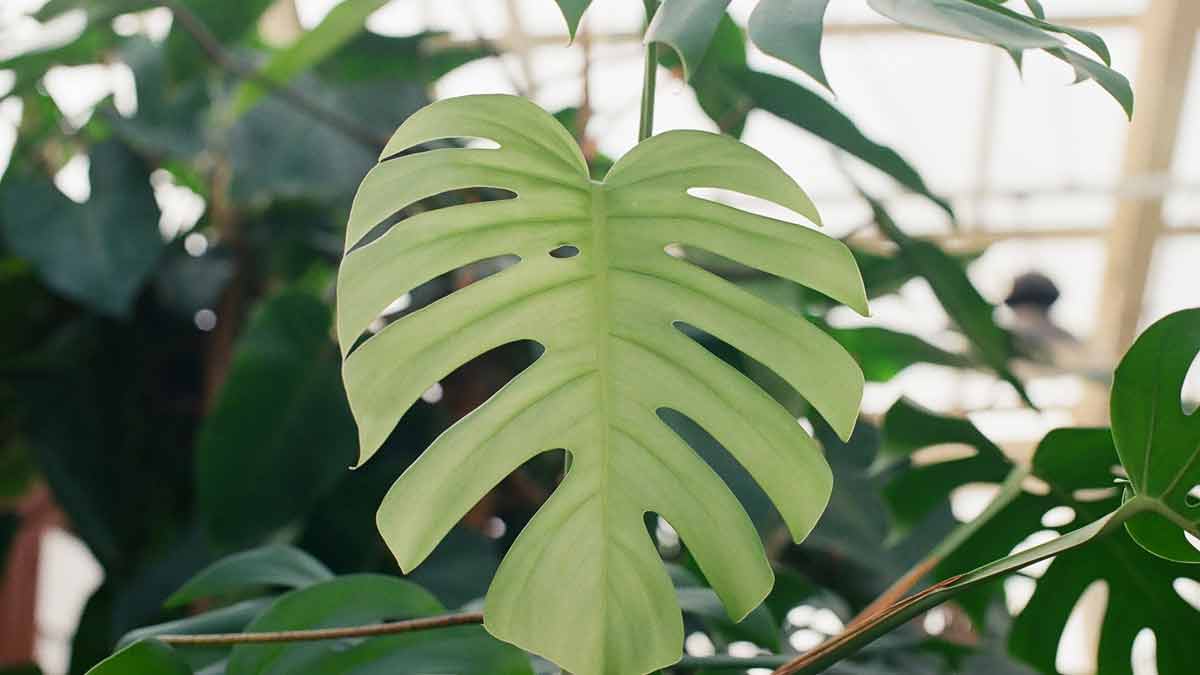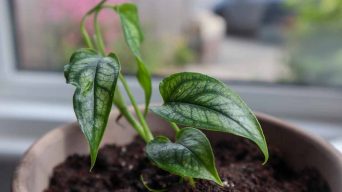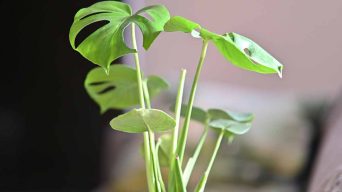Monstera plants can thrive outdoors in zones 10 and 11 but can’t tolerate freezing temperatures. They should be brought inside during colder weather. Monsteras prefer temperatures between 60°F and 80°F and need high humidity levels.
The Monstera plant is a great choice for any indoor gardener, as its lush, green foliage provides a beautiful backdrop to any room, and its hardy nature ensures it will thrive in a variety of conditions.
But did you know that Monsteras can also be grown outdoors?
Here we’ll explore the potential of outdoor growing options for Monsteras and provide tips on how to cultivate them in your own backyard successfully.
Whether you’re looking to create an attractive landscape feature or just want some greenery near your patio, learning about Monstera’s outdoor growth capabilities is essential before taking the plunge.
Monstera Plants and Their Natural Habitat
The Monstera, commonly known as the Swiss cheese plant, is a tropical plant native to Central and South America, where it grows in the understory of rainforests.
The warm and humid conditions of their natural habitat make Monstera a great candidate for outdoor growing in tropical climates.
In more temperate regions, however, some extra planning may be necessary if you want your plant to survive cooler temperatures and less rain.
Ideal Conditions for Growing Monstera Plants Outside
Monstera plants are accustomed to warm temperatures, high humidity levels, and filtered sunlight.
When it comes to growing Monstera outdoors, replicating these conditions is key.
Monstera plants thrive in warm temperatures, so they must be planted in a location that won’t drop below 60°F. The ideal temperature for Monstera plants ranges from 68°F to 75°F.
In terms of water and humidity, Monstera plants require consistent moisture but not overly wet soil. It’s important to allow the soil to dry out slightly between waterings to prevent root rot.
Monsteras prefer soil that is consistently moist but well-draining. This means that the soil should be able to retain moisture without becoming waterlogged or soggy.
If you’re planting your Monstera in a pot or container outside, make sure there are drainage holes at the bottom to allow excess water to escape.
Additionally, these plants thrive in humid environments with plenty of moisture in the air. If you live in a dry climate, consider misting your Monstera regularly or placing a humidifier nearby to keep the air moist.
Sunlight is also crucial for outdoor Monsteras. These plants need bright but indirect light to grow properly.
While indoor Monsteras can tolerate low-light conditions, outdoor plants require more sunlight to thrive.
Ideally, Monstera plants should receive about 6 hours of bright but filtered light each day.
Nutrition is also important for healthy Monstera growth. Fertilize your plant every few months with a balanced fertilizer or one specifically formulated for tropical plants.
One thing to keep in mind when growing Monstera outdoors is that they may be more susceptible to pests and diseases than when grown indoors.
Regularly inspect your plant for signs of infestation or illness and take action promptly if necessary.
Overall, with proper care and attention, Monstera plants can thrive outdoors just as well as they do indoors.
By providing them with the ideal conditions of filtered sunlight, consistent moisture, high humidity levels, and proper nutrition, you can enjoy their stunning foliage in your outdoor space.
Plant Hardiness Zones and the Monstera
Plant hardiness zones are geographical regions categorized based on average minimum winter temperatures.
These zones help gardeners determine which plants can survive in their area and which ones cannot.
The United States Department of Agriculture (USDA) has created a map that divides the country into 13 different zones, ranging from zone 1 (the coldest) to zone 13 (the warmest).
So, what does this mean for growing Monstera outdoors?
Monstera is a tropical plant that thrives in warm and humid conditions. Therefore, it’s important to choose a location that is suitable for its growth. If you live in an area with cold winters, it may be difficult to grow Monstera outside.
According to the USDA Plant Hardiness Zone Map, Monstera can live outside in zones 10 and 11.
These zones are located in areas with warm and tropical climates, such as southern Florida, Hawaii, and Puerto Rico. If you live in one of these areas, you’re in luck! You can enjoy the beauty of this unique climbing houseplant right in your own backyard.
In zones 8 and 9, it may be possible to grow Monstera outdoors in the summer months if temperatures remain consistently warm. However, it’s important to note that these plants will not survive frost or freezing temperatures.
If you live outside of zones 10-11, growing Monstera outdoors is not recommended. In this case, it would be best to keep your plant indoors and move it outdoors during the warmer months.
Temperature Requirements for Monsteras Outside
One of the most crucial factors to take into account when considering whether or not Monstera plants can live outside is the temperature requirements.
Monstera plants are native to tropical climates and prefer temperatures between60°F (15°C) and 80°F (27°C).
If the temperature goes below 60°F (15°C), then it can be detrimental to a Monstera plant, as it may experience frost damage.
Any temperatures above 80°F (27°C) can also cause severe harm and should be avoided.
If temperatures outside don’t remain consistent and stabilize in a tolerable range, then it’s best to keep the plant indoors.
When grown outdoors, the monstera should be placed in partial shade, as full sun will scorch and dry out the leaves.
It’s important to make sure that it stays in a spot where it won’t get exposed to sudden temperature drops or extreme sunlight conditions.
Humidity Requirements for Monstera Plants Outside
If you’re planning on growing Monstera outdoors, it’s important to understand their humidity requirements.
These tropical plants thrive in high-humidity environments, which can be a challenge if you live in a drier climate.
But don’t worry; there are ways to maintain proper humidity levels and keep your Monstera happy and healthy.
First off, let’s talk about why humidity is so important for Monstera.
These plants are native to the rainforests of South and Central America, where they grow under the canopy of tall trees.
In this environment, they receive plenty of moisture from the air and soil. When grown outside of their natural habitat, it’s important to replicate these conditions as much as possible.
The ideal range for Monstera humidity is between 60-80%.
If the levels drop below this range, you may start to see some of the Monstera leaves turn yellow or brown. This is a sign that your plant is not getting enough moisture and needs more humidity.
One way to increase humidity for your outdoor Monstera is through misting. This involves spraying water onto the leaves and surrounding area to create a moist environment.
However, it’s important not to overdo it with misting, as too much water can lead to fungal growth or other issues.
Another option is using a humidifier. This device releases moisture into the air and can be especially helpful during dry seasons or in arid climates.
Place the humidifier near your plant or in the same room for the best results.
If you’re looking for more natural ways to increase humidity outdoors, consider grouping your Monstera with other plants that require high levels of moisture.
As these plants release water vapor into the air through transpiration, they can help create a more humid environment for your Monstera.
In addition to these methods, there are also some general tips for maintaining proper humidity levels outdoors.
For example, avoid placing your plant near sources of dry heat, such as heaters or air conditioning units. Instead, choose a location that receives indirect sunlight and has good airflow.
You can also use mulch around the base of your Monstera plant to help retain moisture in the soil. And don’t forget to water regularly!
Keeping the soil consistently moist will help ensure that your plant has access to enough water.
By following these guidelines, you can create a conducive environment for your Monstera plant and enjoy watching it thrive outdoors.
Can Monstera Live Outside in Summer?
Monstera plants are native to tropical regions, so they thrive in warm and humid conditions.
When growing Monstera outdoors, it’s important to keep them in an area where the temperature ranges from 60°F (15°C) to 85°F (29°C).
These plants can tolerate higher temperatures but may require more frequent watering and misting to prevent dehydration.
During hot summer days, it’s crucial to protect your Monstera from direct sunlight.
Place them under a shaded area or use a shade cloth to filter out intense sunlight. If you notice that your plant is wilting or showing signs of sunburn, move it to a cooler spot immediately.
Tips for Keeping Monsteras Healthy in Hot Weather
To ensure that your Monstera thrives during hot weather, follow these tips:
- Water frequently: During hot weather, Monsteras require more water than usual. Water them thoroughly once a week or whenever the top inch of soil feels dry.
- Provide adequate drainage: Make sure that your pot has adequate drainage holes so that excess water can drain out easily. This prevents waterlogging and root rot.
- Use mulch: Adding mulch around the base of your plant helps retain moisture and regulate soil temperature.
- Mist regularly: Misting your plant regularly helps maintain proper humidity levels and prevents dehydration.
By following these tips and keeping an eye out for signs of stress, you can help your Monstera stay healthy and happy outdoors during the summer.
Can Monstera Live Outside in Winter?
Monsteras are not cold-hardy and can suffer damage if the temperature dips below 50°F (10°C).
If you live in a climate where the temperature drops to freezing or below, it’s best to bring your Monstera indoors during the winter.
If you live in an area with mild winters, you can acclimate your Monstera plant to outdoor conditions gradually.
Start by placing it outside for short periods each day and gradually increase the duration over several weeks. This will allow the plant to adjust to cooler temperatures and lower humidity levels.
When the temperature drops below 50°F (10°C), make sure to cover your Monstera with a frost cloth or plastic sheet. This will help protect it from cold winds and freezing temperatures.
Tips for Keeping Monsteras Healthy in Winter
Monstera plants, in particular, require some extra care during the colder months to keep them healthy and thriving.
Here are some tips to help you keep your plants healthy in winter:
- Adjust watering: During winter, Monstera plants tend to grow slower and require less water. Make sure to adjust your watering schedule accordingly and avoid overwatering, which can lead to root rot.
- Increase humidity: Winter air tends to be dry, which can cause the leaves of your Monstera plant to dry out and turn brown at the edges. To prevent this, increase the humidity around your plant by misting it regularly or using a humidifier.
- Provide adequate light: Monstera plants need bright indirect light to thrive, even in winter. If your plant is not getting enough light, consider moving it closer to a window or providing supplemental lighting with grow lights.
- Keep temperatures consistent: Monstera plants prefer temperatures between 65-85°F (18-29°C). Avoid exposing them to cold drafts or sudden temperature changes, which can stress the plant and make it more susceptible to pests and diseases.
- Monitor for pests: Winter is a common time for pests like spider mites and mealybugs to attack indoor plants. Keep an eye out for any signs of infestation and treat promptly with natural pesticides like neem oil.
Pros and Cons of Keeping Your Monstera Outdoors
Monstera plants can make a great addition to your outdoor garden and can thrive in warm, humid climates.
However, before you take the plunge, it’s important to consider the pros and cons of keeping Monstera plants outdoors.
Pros:
- Vibrant foliage: They produce lush, vibrant foliage that can add color and texture to any outdoor space.
- Low maintenance: They are relatively low-maintenance and don’t require much pruning or fertilizing when grown outdoors.
- Promote growth potential: They can grow to impressive sizes outdoors with the right conditions.
Cons:
- Temperature fluctuations: Plants can suffer from cold damage when temperatures drop below 50°F (10°C).
- Sensitivity to pests and diseases: Outdoor conditions can put plants at risk of pests, disease, and nutrient deficiencies.
- Lack of control over the environment: Growing plants outdoors gives you less control over environmental factors like sunlight, humidity, and temperature.
- Exposure to elements: Outdoor plants can be exposed to harsh rain or wind, sudden temperature changes, and other environmental stressors.
Preparing Monsteras for Outdoor Living
It’s essential to acclimate your Monstera plant to outdoor living gradually.
Sudden changes in temperature and sun exposure can shock the plant and cause damage or even death.
Start by placing your plant in a shaded area outside for a few hours each day, gradually increasing the amount of time it spends outdoors over several weeks.
You need to ensure there is enough light and humidity for your plant, as this will help it thrive outdoors.
If the environment outside is too dry, increase the air moisture by misting or using a humidifier.
Regularly checking for pests and diseases is also important when moving your Monstera outdoors.
Once your plant is acclimated to its new environment, it’s important to provide proper care. Watering is crucial for any plant, but especially for those living outdoors.
Make sure the soil is well-drained and water your plants regularly, keeping the soil moist but not waterlogged.
Fertilization is also important for healthy growth. Use a balanced fertilizer every two weeks during the growing season (spring and summer) to provide essential nutrients.
In addition to proper watering and fertilization, there are other steps you can take to ensure your plant thrives outdoors.
Pruning is necessary to keep the plant from becoming too large or unruly. Remove any dead or damaged leaves regularly, as well as any vines that are getting out of control.
Pests can also be an issue when growing plants outdoors. Keep an eye out for common pests such as spider mites or mealybugs and treat them promptly if detected.
Finally, to protect your Monstera from sudden temperature changes or environmental stressors like wind, you can use a protective barrier such as a plastic cloche.
By following these steps and providing proper care, you should be able to enjoy the beauty of outdoor Monstera plants for years to come.
Final Thoughts
Monstera plants are surprisingly resilient and can live both indoors and outdoors.
Houseplants, such as Monstera, are a great way to bring life and beauty into your home, as they are relatively low-maintenance and can provide lush foliage and vibrant colors for years to come, making them ideal for any home decor.
Depending on your climate and the level of care you can give, you can easily choose to keep a plant inside or outside.
If you’re lucky enough to live in a warmer region, why not take advantage of the balmy weather by keeping your Monstera outdoors?
If you’re in a cooler area, then it’s best to keep your plant inside the house, where the temperature is more regulated, and the environment is more hospitable for the plant.
Either way, with some careful monitoring and attentive care, you can have a happy and healthy Monstera no matter where it lives!







